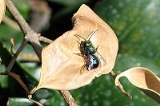
Orchard mason bee
Overview
Megachilidae
The Megachilidae are a cosmopolitan family of solitary bees whose pollen-carrying structure is restricted to the ventral surface of the abdomen...
bee
Bee
Bees are flying insects closely related to wasps and ants, and are known for their role in pollination and for producing honey and beeswax. Bees are a monophyletic lineage within the superfamily Apoidea, presently classified by the unranked taxon name Anthophila...
that makes nests in reeds and natural holes, creating individual cells for their brood that are separated by mud dividers. Unlike carpenter bee
Carpenter bee
Carpenter bees are large, hairy bees distributed worldwide. There are some 500 species of carpenter bee in 31 subgenera...
s, they cannot drill holes in wood. O. lignaria is a common species used for early spring fruit
Fruit
In broad terms, a fruit is a structure of a plant that contains its seeds.The term has different meanings dependent on context. In non-technical usage, such as food preparation, fruit normally means the fleshy seed-associated structures of certain plants that are sweet and edible in the raw state,...
bloom in Japan
Japan
Japan is an island nation in East Asia. Located in the Pacific Ocean, it lies to the east of the Sea of Japan, China, North Korea, South Korea and Russia, stretching from the Sea of Okhotsk in the north to the East China Sea and Taiwan in the south...
, Canada
Canada
Canada is a North American country consisting of ten provinces and three territories. Located in the northern part of the continent, it extends from the Atlantic Ocean in the east to the Pacific Ocean in the west, and northward into the Arctic Ocean...
, and the United States
United States
The United States of America is a federal constitutional republic comprising fifty states and a federal district...
, though a number of species of other Osmia are cultured for use in pollination
Pollination management
Pollination Management is the label for horticultural practices that accomplish or enhance pollination of a crop, to improve yield or quality, by understanding of the particular crop's pollination needs, and by knowledgeable management of pollenizers, pollinators, and pollination...
.
The bees begin to emerge from their cocoons in the spring when the daytime temperature reaches 14°C (57°F).
Unanswered Questions

